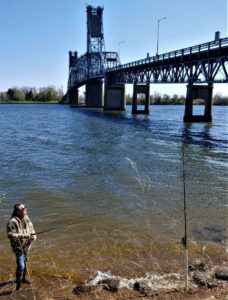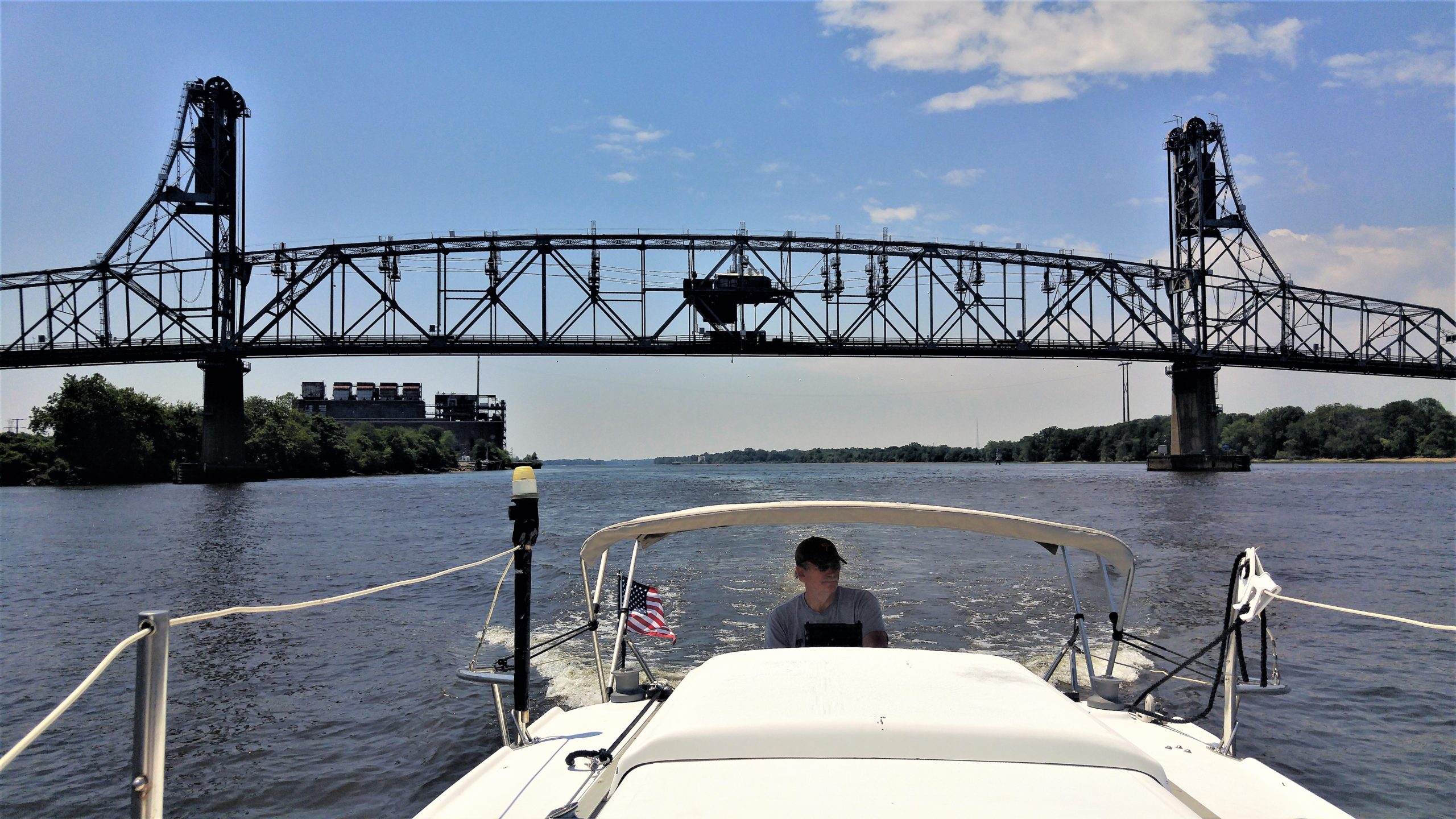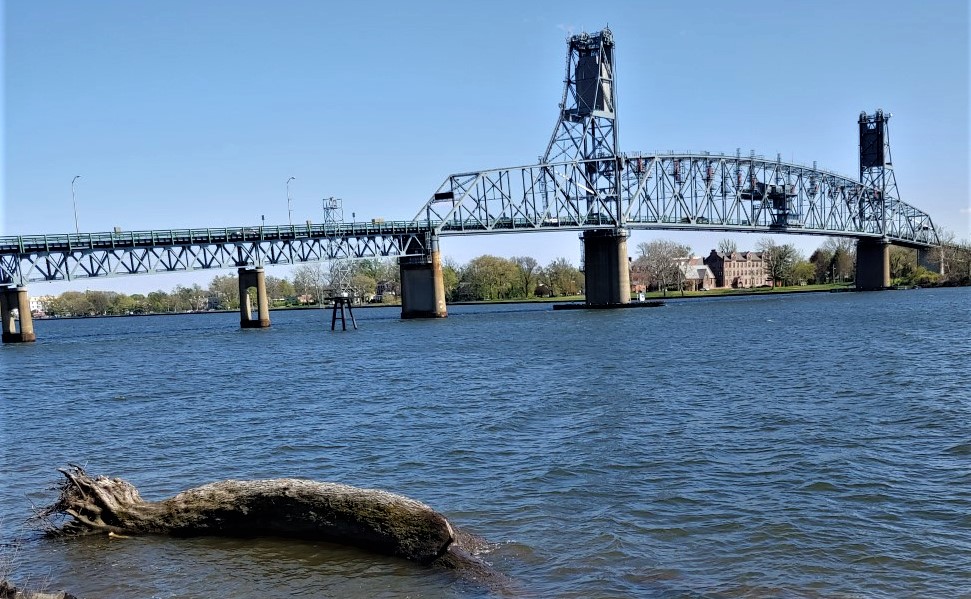Depression-era jobs program put citizens to work building the Bristol-Burlington Bridge.
The other day I was out for a walk in the open along the Delaware River’s high berm below Bristol when I spotted Ken Hinterberger at river’s edge. I had been pondering when the pandemic would end and how the economy would rebound. It was a beautiful, clear day with winds creating a chop on the river – perfect for what the Northampton Township resident was doing. With looping casts of his line, he was hoping to land a few 20-pound striped bass beginning their annual run up the Delaware from the ocean.
I shouted down to Ken, “Mind if I take your picture?”
“Not at all,” he shouted back. “I’m just doing some social distancing.”

I briefly explained I was working up a story for the newspapers about the Burlington-Bristol Bridge built during the Great Depression of the 1930s. Ken nodded, gazing at the 2,300-foot-long steel span overhead.
After the collapse of the stock market in 1929, government put unemployed people to work on lots of different projects. Here in Bucks, Bowman’s observation tower went up overlooking the Delaware River below New Hope. William Penn’s manor house in Falls was reconstructed as a museum. And the new bridge linking Bristol to Burlington City took shape.
The truss span with a central lift – the longest in existence at the time – seemed logical in linking the two sister cities. Farmers in South Jersey were particularly interested to better reach markets in Pennsylvania. In 1930, Congress and the U.S. War Department approved the project, the forerunner of thousands of others across the nation under the soon-to-be-born Public Works Administration. The goal: Build dams, tunnels, highways, houses, schools, courthouses, hospitals, sewage systems plus electrification of rural America and the D.C.-New York rail line passing through Bristol.
The Burlington-Bristol Bridge was to replace a ferry service dating to 1681 when England’s Queen Anne gave a charter to Bristol’s Samuel Clift The shuttle became a critical link in the colonies. American troops guarded it from possible attack by British and Hessian soldiers during the Revolutionary War. After the conflict, small steamboats of the type invented by John Fitch of Warminster went into service under the Doron family of Bristol. The last ferryboat – the William S. Doron – ceased operations just before the bridge opened.
Initially, the plan was to build the span in two legs – one from Market Street in Bristol to Burlington Island, then from the mid-river island to Reed Street in Burlington City. However flights from the Keystone Flying Field in Bristol posed a danger. Also, the route would have leveled historic homes and a business park in Burlington City. So, the project relocated one mile downstream to its present location linking Route 413 below Bristol to Reed Street.
Work began on April 1, 1930 with construction of cement piers on which to mount the superstructure with a 24-foot-wide, two-lane roadway. Twin 80-horsepower engines motorized the center lift by raising and lowering cement slabs poised on towers 220 feet above the river at each end of the lift span. Put in motion, they effortlessly hoisted the roadway 61 feet above high tide, enabling ships to pass under to manufacturers as far north as Trenton.

Work on the $1.5 million project ($23 million today) was completed in an astonishingly quick 13 months, opening to traffic on May 2, 1931. The bridge has served the public to the present time. Crossing can be nerve-racking. Newspaper columnist and colleague J.D. Mullane aptly described the sensation a few years ago: “The bridge rises fast, as does my heart rate. Sweat breaks out. I place a death grip on the wheel. Once past the smoothly paved approaches, tires hit the metal grate in the center of the span, which clacks and clatters like the Cyclone roller coaster at Coney Island. I look straight ahead and not side to side, since one is mere feet from a seven-story plunge into the Delaware River.”
That happened in 1974 when a guard failed to halt traffic during a lift. A motorist perished as his vehicle plunged into the night void. Since then, traffic lights and automatic gates have been installed at both ends of the bridge.
As I strolled the waterfront under the bridge, I had flashbacks to the joy of participating two summers ago in a sailboat regatta beside the bridge. Crossing the bridge to Curtin’s Marina in Burlington City to enjoy dining and live music on a tiki deck as the sun dipped below the bridge is a summer tradition. All is apt to change this year due to shutdowns and the lurking COVID-19 virus. With massive unemployment and rumors of an economic depression ahead, a rebirth of public works projects like the Burlington-Bristol Bridge in the 1930s seems likely.
Sources include “Our Oldest Town” by historian Jeffrey Marshall published in Bucks County Magazine on March 13, 2013; “Scary old Burlington-Bristol Bridge” by J.D. Mullane published in the Bucks County Courier Times on Aug. 11, 2015, and “Burlington-Bristol Bridge Historic Overview” on the web at http://www.phillyroads.com/crossings/burlington-bristol/
Bridge openings are posted daily on the Web at
http://local.nixle.com/burlington-county-bridge-commission-police-department/

